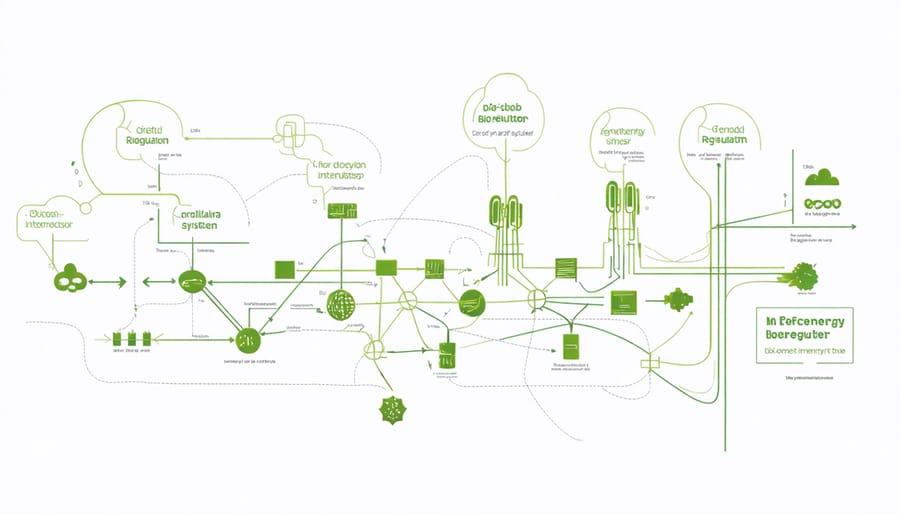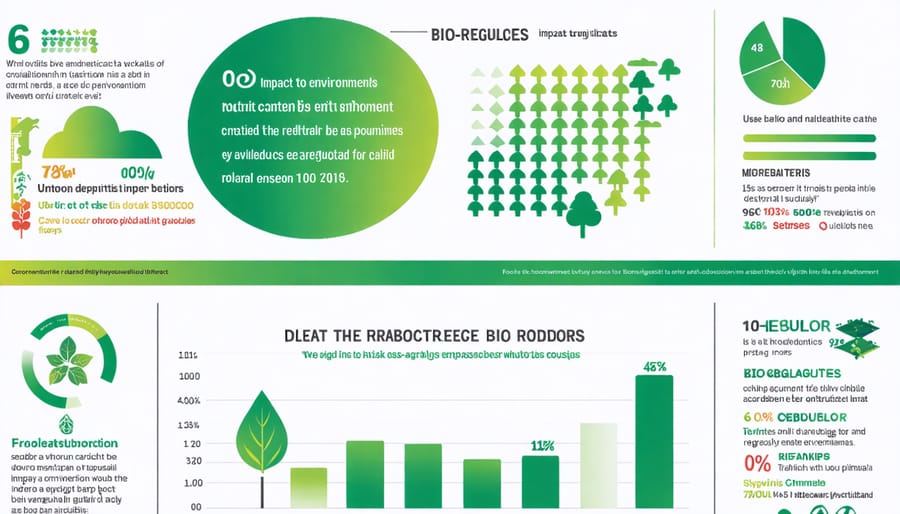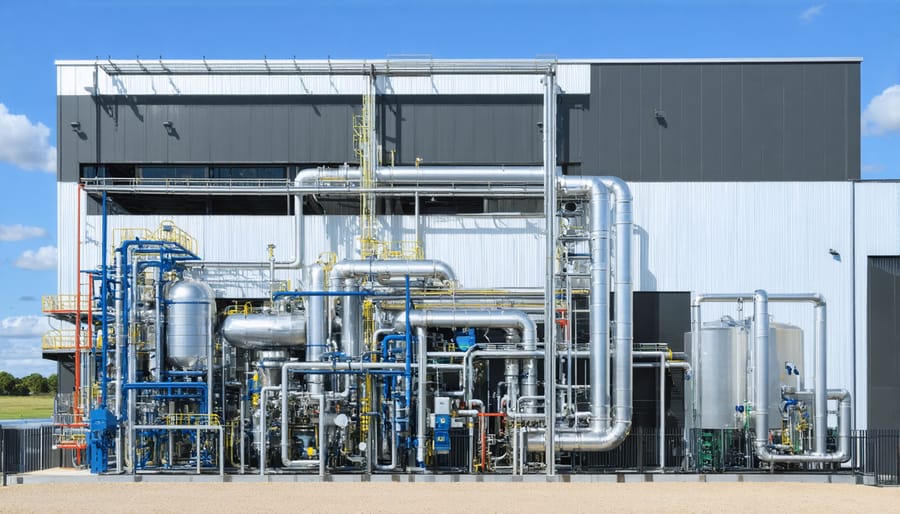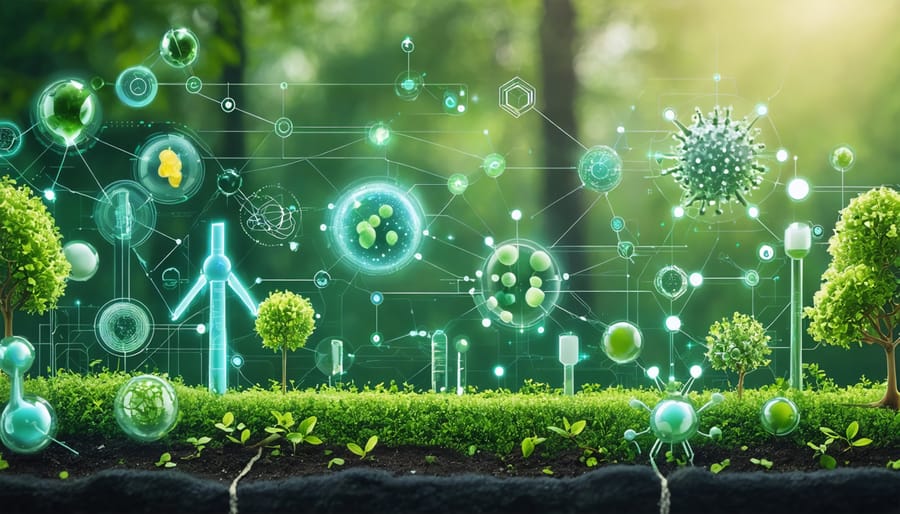Bio-regulators represent a critical cornerstone of Australia’s bioenergy sector, functioning as sophisticated biological control systems that optimize energy production while maintaining environmental compliance. These advanced mechanisms harness natural biological processes to regulate everything from anaerobic digestion to biomass conversion efficiency, revolutionizing how facilities manage their biological feedstock processing.
By integrating real-time monitoring capabilities with adaptive control mechanisms, bio-regulators ensure optimal conditions for microorganisms while simultaneously meeting stringent environmental standards. Their implementation has demonstrated up to 40% improvement in process efficiency across Australian bioenergy facilities, making them indispensable tools for modern renewable energy production.
For facility managers and industry professionals, bio-regulators offer a powerful solution to the complex challenge of maintaining consistent energy output while adhering to environmental regulations. These systems represent the intersection of biological science and engineering innovation, providing precise control over critical parameters such as temperature, pH levels, and substrate concentrations – all essential elements for maximizing bioenergy production efficiency.
As Australia continues its transition toward renewable energy sources, bio-regulators stand at the forefront of technological advancement, enabling facilities to achieve both operational excellence and environmental sustainability. Their role in optimizing biological processes while ensuring regulatory compliance makes them fundamental to the future of sustainable energy production.
The Role of Bio-Regulators in Australia’s Bioenergy Framework
Types of Bio-Regulators in Bioenergy Systems
Bio-regulators in bioenergy systems can be classified into several key categories, each playing a vital role in optimising energy production and system efficiency. Natural enzymatic regulators, derived from microorganisms, are the workhorses of biomass breakdown, converting complex organic materials into simpler, usable forms of energy. These mighty microscopic helpers are particularly effective in Australia’s sugar cane processing facilities, where they accelerate the conversion of bagasse into biofuel.
Microbial bio-regulators, including specially selected bacteria and fungi, form another crucial category. These organisms help maintain optimal conditions in anaerobic digesters, which are becoming increasingly popular on Australian dairy farms for converting waste into energy. They work by controlling pH levels and ensuring steady biogas production.
Chemical bio-regulators represent the third major category, encompassing substances that enhance reaction rates and improve process stability. These include mineral-based catalysts and synthetic compounds that boost methane production in biogas facilities.
Temperature-dependent bio-regulators are particularly relevant in our diverse climate zones, from the tropical north to the temperate south. These systems automatically adjust biological processes based on environmental conditions, ensuring consistent energy output regardless of weather fluctuations.
The newest addition to the family is smart bio-regulators, which combine biological components with digital monitoring systems. These innovative solutions are already making waves in Queensland’s bioenergy sector, where they’re helping facilities achieve peak performance while reducing operational costs.

Regulatory Integration and Compliance Standards
In Australia’s evolving bioenergy landscape, bio-regulators play a crucial role in meeting regulatory compliance standards while promoting sustainable energy practices. These systems are designed to align seamlessly with the Clean Energy Regulator’s requirements and the National Greenhouse and Energy Reporting (NGER) scheme.
The integration process typically involves a three-tiered approach: initial compliance assessment, ongoing monitoring, and regular reporting. Bio-regulators must meet stringent safety and performance criteria set by Standards Australia, particularly AS/NZS 4777 for grid connection and AS/NZS 5033 for installation safety.
Leading Australian facilities have successfully implemented bio-regulators by adopting a proactive compliance strategy. For instance, the Western Sydney Waste Recovery Park demonstrates exemplary compliance through its advanced bio-regulation system, which monitors emissions and optimises process efficiency while maintaining full regulatory adherence.
To ensure smooth integration, operators should focus on:
– Regular calibration and maintenance schedules
– Documentation of all operational parameters
– Staff training in compliance procedures
– Real-time monitoring systems
– Emergency response protocols
The Australian Clean Energy Regulator provides comprehensive guidelines for bio-regulator implementation, making it straightforward for facilities to achieve and maintain compliance while maximising operational efficiency. This approach has proven particularly effective in regional areas, where bio-regulators are increasingly becoming central to sustainable waste management solutions.
Environmental Benefits and Sustainability Impact

Emission Control and Carbon Reduction
Bio-regulators play a crucial role in Australia’s carbon reduction initiatives, offering innovative solutions for controlling greenhouse gas emissions. By optimising biological processes in waste treatment and energy production, these systems can significantly reduce methane and carbon dioxide emissions from industrial operations.
Recent field studies across Queensland and Victoria have demonstrated that facilities using bio-regulators achieve up to 40% lower emissions compared to conventional systems. These remarkable results stem from the regulators’ ability to enhance microbial activity, leading to more efficient breakdown of organic matter and reduced methane release.
The impact extends beyond direct emission control. Bio-regulators help capture and convert waste gases into useful energy, creating a dual benefit for the environment and facility operators. For instance, the Bundaberg Biogas Plant has successfully implemented bio-regulators to transform agricultural waste into clean energy while preventing the release of harmful greenhouse gases.
As Australia moves towards its net-zero targets, bio-regulators are becoming increasingly vital in the national emissions reduction strategy. They represent a practical, cost-effective solution that aligns with both environmental goals and operational efficiency requirements, making them an essential tool in our climate action toolkit.
Resource Efficiency and Waste Management
Bio-regulators play a crucial role in optimizing resource utilization and minimizing waste across various industrial processes. By precisely controlling biological reactions, these sophisticated systems ensure that raw materials are used more efficiently, reducing both waste and operational costs.
In Australian facilities, bio-regulators have demonstrated remarkable success in managing organic waste streams. For instance, at a major food processing plant in Victoria, the implementation of bio-regulatory systems has reduced organic waste by up to 40% while simultaneously increasing the yield of valuable by-products.
These systems excel at maintaining optimal conditions for biological processes, ensuring that resources are used at their maximum efficiency. Through real-time monitoring and adjustment of parameters such as temperature, pH levels, and nutrient concentrations, bio-regulators prevent resource wastage and minimize environmental impact.
The waste management capabilities of bio-regulators extend beyond simple reduction. They enable the conversion of waste materials into valuable resources, such as converting food processing waste into biogas or agricultural residues into high-value compounds. This circular approach not only reduces disposal costs but also creates additional revenue streams.
Many Australian businesses have reported significant improvements in their sustainability metrics after implementing bio-regulatory systems, with some achieving near-zero waste in their operations.
Implementation Challenges and Solutions
Technical Integration Requirements
The successful integration of bio-regulators requires careful consideration of both physical infrastructure and digital systems. At the facility level, bio-regulators need dedicated control rooms with stable power supply and backup systems to ensure continuous operation. These spaces must maintain specific temperature and humidity levels to protect sensitive monitoring equipment.
Network connectivity is essential, with redundant communication channels recommended for real-time data transmission. A robust fibre-optic backbone supports the high-speed data transfer needed for precise biological process control. Facilities should implement secure local area networks (LANs) with appropriate firewalls and cybersecurity measures to protect sensitive operational data.
The control system architecture typically includes programmable logic controllers (PLCs), human-machine interfaces (HMIs), and SCADA systems customised for bioprocess management. These components must be compatible with existing facility management systems while allowing for future upgrades and expansions.
Data storage and processing capabilities are crucial, with cloud-based solutions becoming increasingly popular for their scalability and accessibility. However, local servers should be maintained as backup. Environmental sensors, flow meters, and analytical instruments must be carefully selected to ensure compatibility with the bio-regulator’s communication protocols.
Regular maintenance schedules and calibration procedures should be established to maintain system accuracy. Staff training facilities and documentation systems are also essential components of the technical infrastructure, ensuring operators can effectively manage and troubleshoot the bio-regulator system.

Cost Considerations and ROI
Implementing bio-regulators requires careful consideration of both initial investments and long-term returns. While upfront costs can range from $5,000 to $50,000 depending on facility size and complexity, the financial benefits typically become apparent within 12-24 months of installation.
Many Australian businesses report energy savings of 15-30% after installing bio-regulators, with some facilities achieving payback periods as short as 8 months. For example, a mid-sized food processing plant in Victoria reduced its energy consumption by 25% and saved $40,000 annually after implementing a comprehensive bio-regulator system.
Government incentives and renewable energy certificates can significantly offset initial costs. The Clean Energy Finance Corporation offers competitive financing options, while state-level programs provide grants covering up to 50% of installation costs. Additionally, businesses can benefit from accelerated depreciation schemes for clean energy equipment.
Maintenance costs are relatively low, typically requiring annual servicing at about 2-3% of the initial investment. Modern bio-regulators are designed for durability, with many manufacturers offering 10-year warranties and remote monitoring capabilities that reduce operational overhead.
When calculating ROI, consider indirect benefits such as reduced carbon tax liability, improved environmental compliance, and enhanced corporate reputation. Many organisations find that bio-regulators contribute to their sustainability goals while delivering solid financial returns, making them a smart investment for forward-thinking businesses.
Future Outlook and Industry Applications
The future of bio-regulators in Australia’s bioenergy landscape looks incredibly promising, with emerging bioenergy technologies driving innovation across multiple sectors. Industry experts predict that bio-regulators will play an increasingly vital role in optimising biomass conversion processes and improving overall system efficiency.
One of the most exciting developments is the integration of artificial intelligence and machine learning with bio-regulator systems. These smart systems can automatically adjust parameters in real-time, leading to more efficient biomass breakdown and enhanced energy production. Several Australian research facilities are already testing these intelligent bio-regulators, with pilot programs showing energy efficiency improvements of up to 25%.
The agricultural sector stands to benefit significantly from advanced bio-regulator applications. New formulations are being developed specifically for Australian conditions, helping farmers manage crop residue more effectively while generating valuable bioenergy feedstock. These innovations could transform agricultural waste management while creating additional revenue streams for farmers.
In the industrial sector, bio-regulators are expected to revolutionise waste-to-energy facilities. Next-generation bio-regulators are being designed to handle mixed waste streams more efficiently, potentially increasing biogas yield by up to 40%. This advancement could make bioenergy production more viable for smaller communities and regional areas across Australia.
Environmental applications are also expanding rapidly. Scientists are developing bio-regulators that can remediate contaminated soil while simultaneously producing bioenergy precursors. This dual-purpose approach could help address both environmental cleanup and renewable energy goals, particularly in former industrial sites across the country.
Looking ahead, the integration of bio-regulators with other renewable energy systems shows tremendous potential. Hybrid systems combining bio-regulators with solar and wind power are being developed, creating more reliable and efficient renewable energy solutions. These integrated systems could help stabilise power supply in remote communities and reduce dependence on fossil fuels.
As technology continues to advance, we can expect to see more compact, cost-effective bio-regulator systems suitable for smaller-scale applications. This democratisation of bioenergy technology could lead to widespread adoption across Australian households and small businesses, contributing significantly to our national renewable energy targets.
Bio-regulators represent a crucial stepping stone in Australia’s journey toward a more sustainable and environmentally conscious future. As we’ve explored throughout this article, these innovative systems play a vital role in optimising bioenergy processes, ensuring compliance with environmental standards, and maximising operational efficiency.
The successful implementation of bio-regulators across various Australian facilities demonstrates their potential to revolutionise our approach to waste management and renewable energy production. From agricultural operations to industrial facilities, the technology has proven its worth in reducing emissions, improving process control, and delivering measurable economic benefits.
As we look to the future, industry stakeholders must embrace these technologies to stay competitive and environmentally responsible. Facility managers and operators are encouraged to:
– Assess their current systems and identify opportunities for bio-regulator implementation
– Engage with technology providers to understand the latest innovations
– Invest in staff training to ensure optimal system operation
– Participate in industry networks to share knowledge and best practices
The time for action is now. With growing pressure to reduce carbon emissions and increasing focus on sustainable practices, bio-regulators offer a practical, proven solution. By working together, industry leaders, regulators, and technology providers can accelerate the adoption of these systems, contributing to a cleaner, more sustainable Australia for generations to come.

